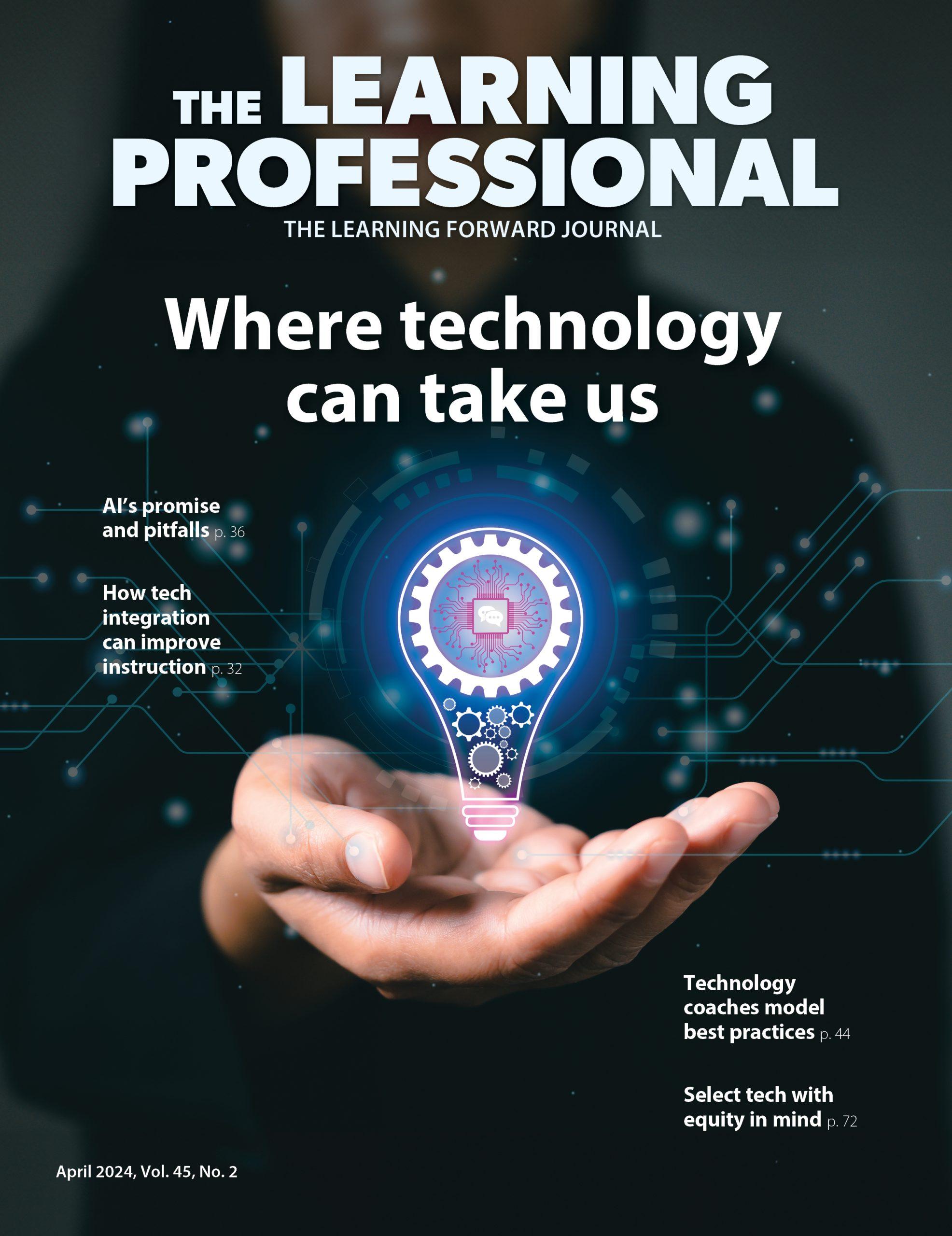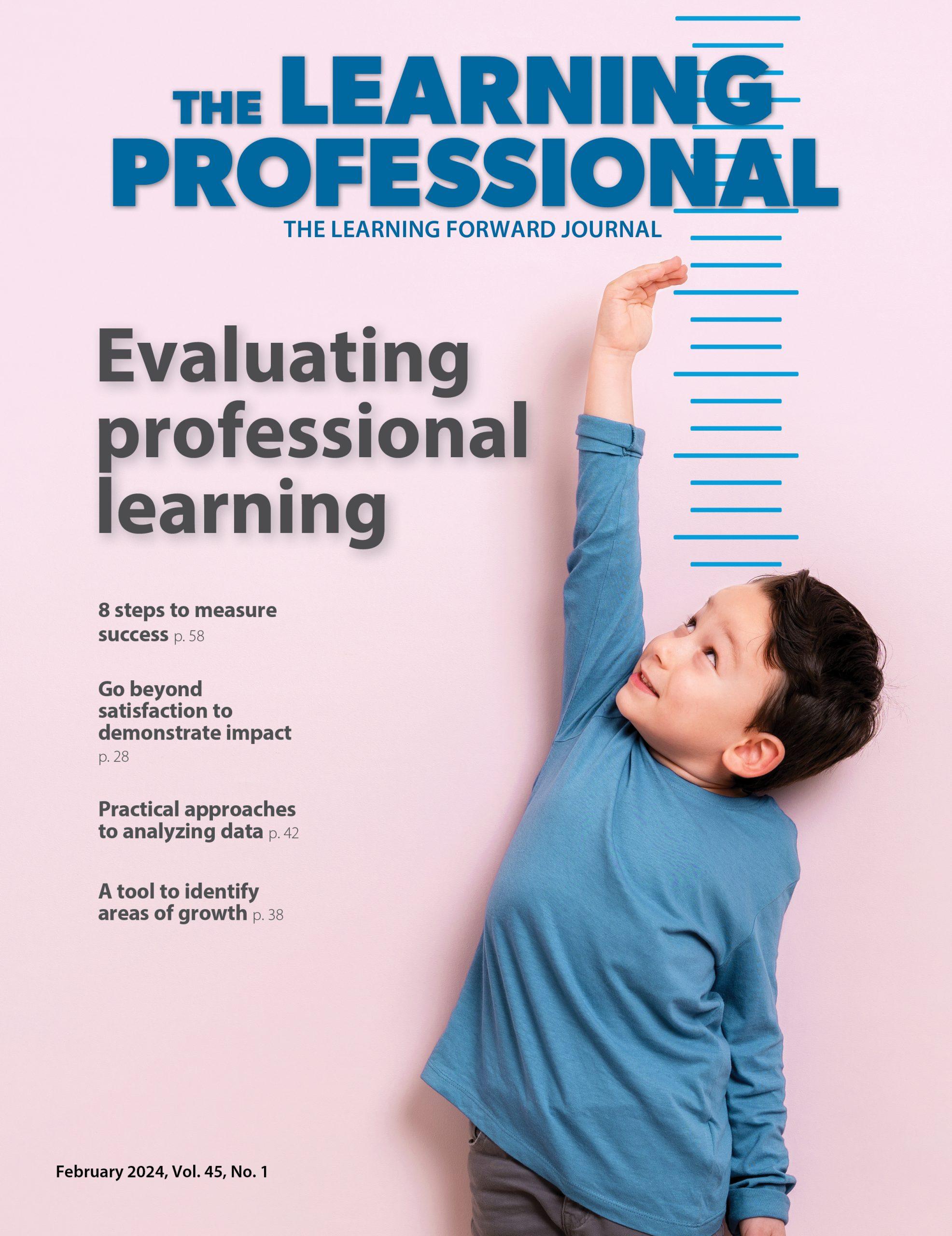Myths About Technology-Supported Professional Learning
By Learning Forward
Categories: Learning designs, TechnologyApril 2014
Read the remaining content with membership access. Join or log in below to continue.
Sed ut perspiciatis unde omnis iste natus error sit voluptatem accusantium doloremque laudantium, totam rem aperiam, eaque ipsa quae ab illo inventore veritatis et quasi architecto beatae vitae dicta sunt explicabo. Nemo enim ipsam voluptatem quia voluptas sit aspernatur aut odit aut fugit, sed quia consequuntur magni dolores eos qui ratione voluptatem sequi nesciunt. Neque porro quisquam est, qui dolorem ipsum quia dolor sit amet, consectetur, adipisci velit, sed quia non numquam eius modi tempora incidunt ut labore et dolore magnam aliquam quaerat voluptatem.
Align Resources To Standards
Access contributes to learning, yet educators must use what they access to strengthen their practice to impact student success. Those making decisions about educator support systems should align resources to the educator performance standards and student learning standards. The more aligned and relevant resources are to educator and student standards, the more likely it is that accessing support systems will contribute to professional learning that results in change in practice and student success.
Myth 2
Knowledge equals practice.
“One must learn by doing the thing, for though you think you know it, you have no certainty until you try.”
Sophocles
Many developers of online learning products base their work on the assumption that knowledge leads to application. The research of Bruce Joyce and Beverly Showers (2002) counters this assumption. They surmise from multiple research studies about changing instructional practice that presenting theory, information, concepts, or principles alone is insufficient in promoting application of learning.
They further suggest that seeing models or demonstrations does little to promote application. Even intentional practice has little influence. What is most influential in promoting application of new learning is deeper study, coaching, and feedback.
Benjamin Bloom places knowledge and comprehension at the lowest levels of his taxonomy of levels of understanding. The premise is that knowing and comprehending are less cognitively complex than those levels of understanding that follow — application, analysis, evaluation, and creating.
Donald Kirkpatrick and James Kirkpatrick (2006) describe levels for the evaluation of training that place acquisition of knowledge at the second of four levels, application at the third level, and results for clients as the final level.
Grant Wiggins and Jay McTighe (2005) identify explaining — providing thorough and justifiable accounts of phenomena, facts, and data, as the first of six facets of understanding.
Knowing or comprehending may initiate the change in knowledge and skills that lead to application of learning and eventually produce results for students; however, alone they are insufficient to be equated with professional learning. Too often, some models of online learning depend on a knowledge transmission approach to learning. If it fails to include application of learning in multiple contexts, plus an analysis of and reflection on practice, is it professional learning?
Change in professional practice begins with knowledge and ends when the educator thoroughly analyzes available resources, contemplates how to adapt them to his or her unique circumstance, makes those adaptations, applies the adaptations in practice, and reflects on the effectiveness of the practice in terms of benefits for students. Professional learning is measured in expanded knowledge and skills, refinements in practice, and impact on student learning.
Myth 3
Individualized learning alone transforms schools.
“Episodic and ineffective professional development is replaced by professional learning that is collaborative, coherent, and continuous and that blends more effective in-person courses and workshops with the expanded opportunities, immediacy, and convenience enabled by online learning.”
U.S. Department of Education
Office of Educational Technology, 2010
Technology enables powerful new online learning opportunities for educators to experience individualized, interest-driven, just-in-time learning that can be pursued anytime, anyplace, and with any device. This kind of personalized learning addresses common challenges of one-size-fits-all professional development and removes the barriers of time and place that limit busy teachers’ access to the professional learning they need and want.
For these reasons, individualized online learning models are growing rapidly, with an increasing number of educators engaging in their own online personal learning networks using a variety of social media tools and accessing online journals, encyclopedias, tutorials, other media, and resources based on their own needs, with just-in-time support where and when they need and want it.
Twitter chats, blogs, Nings, Google+ groups and communities, Open Education repositories, digital museum resources, and online libraries all offer a proliferation of educator-focused online resources. An Education Week Teacher article titled “Fighting teacher isolation with technology” describes how individualized, interest-driven learning is rapidly spreading in popularity (Magiera, 2013).
The U.S. Department of Education-funded Connected Educators initiative is an example of a large-scale, free, online professional opportunity that is engaging thousands of educators from across the country on a range of topics of interest to them. The initiative sponsored a Connected Educators Month in October 2013 with more than 600 events.
While self-directed online learning models provide effective ways to address individual educator learning goals, educators are not solo contractors, nor is learning a solitary process. Educators work interdependently with other educators to achieve team, school, district, and state goals for student learning.
Individual learning therefore may increase variance among classrooms, leading to higher differences in student learning. Individual learning is insufficient to achieve success for all students within a school. In a recent study of the diffusion of professional development, researchers found that sharing expertise through collegial interactions has nearly the same effect on changes in instructional practices as direct engagement in professional development (Sun, Penuel, Frank, Gallagher, & Youngs, 2013).
Ideally, platforms for professional learning should blend individual and collaborative learning to diffuse effects among educators. Educator professional learning plans should include a combination of both individualized and collaborative online approaches within a continuum of learning opportunities, both online and face-to-face.
As a result, platforms for professional learning must engage educators in purposeful collaboration with a community of learners designed to meet not only individual learning goals, but also those of teams, schools, districts, and programs. Such communities can provide powerful ways to address specific school, district, and programmatic learning goals systemically — goals that may not be as easily or fully achieved by individuals engaged in independent, online, or face-to-face professional learning.
Essential Knowledge
InTASC Model Core Teaching Standards incorporate performance, knowledge, and dispositions and define them as follows:
“ ‘Essential knowledge’ signals the role of declarative and procedural knowledge as necessary for effective practice, and ‘critical dispositions’ indicates that habits of professional action and moral commitments that underlie the performances play a key role in how teachers do, in fact, act in practice” (CCSSO, 2011, p. 6).
References
Council of Chief State School Officers. (2011). InTASC model core teaching standards: A resource for state dialogue. Washington, DC: Author.
Freire, P. (1998). Teachers as cultural workers: Letters to those who dare teach. Boulder, CO: Westview Press.
Gee, J.P. (2013). The problem with the school of one: Can technology make education too customized for the student? Slate Group. Available at https://slate.me/MKYmjd.
Joyce. B. & Showers B. (2002). Student achievement through staff development (3rd ed.). Alexandria, VA: ASCD.
Kirkpatrick, D. & Kirkpatrick, J. (2006). Evaluating training programs: The four levels. San Francisco, CA: Berrett-Koehler.
Learning Forward. (2011). Standards for Professional Learning. Oxford, OH: Author.
Magiera, J. (2013). Fighting teacher isolation with technology. Education Week Teacher. Available at https://bit.ly/1j3F5UZ.
Powerful Learning Practice. (2013). Connected educator starter kit. Available at https://plpwiki.com/file/view/starter-kit-final.pdf.
Sun, M., Penuel, W.R., Frank, K.A., Gallagher, H.R., & Youngs, P. (2013, April). Shaping professional development to promote the diffusion of instructional expertise among teachers. Educational Evaluation and Policy Analysis, 35(3) 344-369.
U.S. Department of Education Office of Educational Technology. (2010). Transforming American education: Learning powered by technology. National education technology plan. Washington, DC: Author. Available at www.ed.gov/sites/default/files/netp2010.pdf.
Wiggins, G. & McTighe, J. (2005). Understanding by design. Alexandria, VA: ASCD.
Learning Forward is the only professional association devoted exclusively to those who work in educator professional development. We help our members plan, implement, and measure high-quality professional learning so they can achieve success with their systems, schools, and students.
Categories: Learning designs, Technology
Recent Issues
LEARNING TO PIVOT
August 2024
Sometimes new information and situations call for major change. This issue...
GLOBAL PERSPECTIVES
June 2024
What does professional learning look like around the world? This issue...
WHERE TECHNOLOGY CAN TAKE US
April 2024
Technology is both a topic and a tool for professional learning. This...
EVALUATING PROFESSIONAL LEARNING
February 2024
How do you know your professional learning is working? This issue digs...








